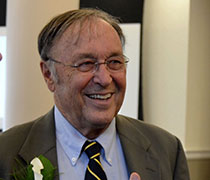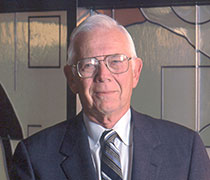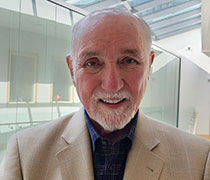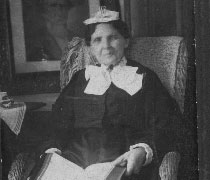 This story appears in the June 2024 GēDUNK
This story appears in the June 2024 GēDUNK
Impact 150: The Anniversary Campaign for Grove City College is more than a historic fundraising and strategic building campaign to position the College for the future, it is a celebration of the history and legacy of Grove City College as it nears its sesquicentennial in 2026.
The College has had a significant impact over the last century and a half – not only on the tens of thousands of students whose lives have been transformed by the lessons learned, relationships formed, and faith fostered on campus – but on a world that has changed dramatically in that time. Over the next few years as we approach our milestone anniversary, we are going to be highlighting 150 for 150, a selection of people who embody 150 years of Grove City College history, and the excellence and faithfulness that are our hallmarks.
They are people who have made an impact on the College and the world beyond campus during the last century and half. Some are key figures in Grove City College’s history, while others are accomplished alumni, legendary faculty, or simply beloved members of the College community. They shaped, and were shaped by, the distinctive character of this special place and they are exemplars of Grove City College’s mission, vision, and values. We’re rolling the150 for 150 out in the pages of The GēDUNK until 2026 when we reach the College’s 150th anniversary. To best represent the scope of the College’s impact, each installment will include a cross section of “great Grovers” without regard to any ranking or chronology.
 DAVID M. LASCELL
DAVID M. LASCELL
Trustee Emeritus David M. Lascell didn’t attend or graduate from Grove City College but the New York attorney was, at a critical point in history, the College’s greatest advocate. His impact on the College was profound and still felt more than four decades after he took up the Crimson and White banner.
Lascell wrote the brief in the landmark Grove City College v. Bell lawsuit and argued the case from the Western District of Pennsylvania to the well of the U.S. Supreme Court. The case stemmed from the College’s refusal to agree to comply with new and future regulations stemming from Title IX, the law requiring federally funded institutions to provide women equal access to athletic programs.
Grove City College’s longtime stance against accepting federal funding seemed to inoculate the College against any fallout from refusing to, essentially, allow the U.S. government to determine the Christian private institution’s fate. But it was more complicated than that and a legal battle ensued. (See the story on page 40.) As he pleaded the case, Lascell used an “arcane” legal maneuver to establish, as a legal fact, that Grove City College did not and had not discriminated against anyone. “The only fact we have is that we’re doing this as a matter of principle,” Lascell said.
Eventually the case made its way to the Supreme Court, where Lascell laid out the College’s case succinctly. “Grove City claims no right to discriminate and does not do so. Grove City receives not one cent of federal aid, claims no right to receive federal aid, and does not want any federal aid. Grove City, however, thinks that the student aid program was created so that students can chose among educational institutions … That ought not mean that the entire educational institution is subject to the entire range of federal regulation,” he argued.
The high court’s decision – student aid was federal support, but the government could only regulate the office that received the money, in Grove City’s case the financial office – was technically a loss for the College. But thanks in no small part to Lascell’s advocacy, the case established Grove City College’s national reputation as a school that stands up for principle, no matter the cost.
And the cost was very high, a point that Lascell made in later years as he served as vice chair of the Board of Trustees and Emeritus Trustee. To comply with the court’s decision, Grove City College stopped allowing students to accept federal grants and loans. While the College has been able to provide private aid and loan programs to help students, the move has cost millions over the years.
Taking on “the most powerful of adversaries – the United States government,” Lascell said, cut the College off from largest source of funding for student aid, research, and myriad other expenses. “Making up the difference requires enormous amount of work,” he said on the 25th anniversary of Grove City College v. Bell. “To thrive over the next decades, this college and its supporters will have to find remarkable amounts of alternative funding … Like so many worthwhile principles, freedom and independence here come at a very high price.”
In 2015, Lascell received a well-deserved Distinguished Service Award from the Alumni Association. He died in 2016.
 J. PAUL STICHT ’39
J. PAUL STICHT ’39
J. Paul Sticht was a legendary chief executive who led TWA, Campbells Soup, Federated Department Stores, and RJR Nabisco Inc. and, over the course of his career, helped create the international corporation.
He was also a force in the life and history of Grove City College, serving on the Board of Trustees for 40 years, five of them as chair. His service from 1963 to 2003 spanned one of the most critical eras of the College’s history.
Born in 1917 in western Pennsylvania, Sticht worked his way through Grove City College, where he met wife Ferne (Cozad ’38) and earned a degree in 1939. He went to work with his father in a steel mill before joining Howard Hughes’ Trans World Airlines in 1941. After several years with the globally expanding airline, he moved on to the Campbell Soup Co. where he was vice president of its international arm. In 1960 he joined Federated Department Stores as the first executive from outside the founding Lazarus family and eventually became its president in 1967.
In 1973 he was named president of the R.J. Reynolds tobacco company and guided it to new markets overseas, new product areas, and acquisitions including Del Monte, Nabisco, and Kentucky Fried Chicken. Sticht essentially moved R.J. Reynolds from a domestic tobacco company into a broad-based international corporation. Sales grew from $2.5 billion to $15 billion when he retired in 1984. He returned to the conglomerate to serve as chairman in 1987 and 1989.
He died in 2007, leaving a legacy as a titan of the post-war American business world and a generous supporter and able leader of his alma mater. He was honored with a Distinguished Service Award from the Alumni Association in 2003 and granted Trustee Emeritus status in 2004. His memory lives on at the College in the Sticht Lecture Hall of the Staley Hall of Arts and Letters and the in the Business and Ethics lecture series that bears his name.
 BILL SMITH ’69
BILL SMITH ’69
When Bill Smith graduated from Grove City College, his only experience with computers was the IBM punch cards used to track Chapel attendance.
But his first job out of school was selling the machines for RCA, so he
put in the time and effort to learn how they worked, how to program them, and what they could do. After more than a decade in the industry in 1982, he took an entrepreneurial leap and started his own company to create connection-management software, just as the world was beginning to discover how computers would become part of everyday life.
Over the last four decades, he has overseen the growth of Smith Micro Software as the company adapted to changes in the market, went public, and saw its products become part of the cell and smartphone revolution. That longevity and sustained success is unusual in the sometimes volatile industry. “Working in the tech world is not for the faint of heart … You have to have a foundation and you have to stick to it. I think that the education I got at Grove City really prepared me for that,” Smith said.
Like many other successful alumni over the course of College history, Smith is a generous benefactor. He and his wife Dieva are lead donors to Impact 150: The Anniversary Campaign for Grove City College. In recognition of their support, Rockwell Hall will be renamed Smith Hall of Science and Technology when renovations are complete. Smith is also a big supporter of two programs that reflect his professional achievements: Computer Science and Entrepreneurship. In addition to hiring Computer Science graduates, Smith Micro Software partners with faculty and students working on capstone projects and doing research.
While business and technology has changed significantly since the 1960s, Smith says his education ‘mid the pines was comprehensive, exposing him to what makes a business work, and providing a skillset that helped him be an effective CEO. He cites legendary economics professor Dr. Hans Sennholz as a favorite and said he took every class from the Austrian economics advocate that he could.
“What makes Grove City special is the fact that not only are you learning the skills in the discipline that you have chosen to study, but you’re also learning how to live your life in a better way,” Smith said.
 JIM LONGNECKER
JIM LONGNECKER
Jim Longnecker was a “player’s coach” long before the term became part of the sports vernacular. Over his 40 seasons as a coach and faculty member, his knowledge, enthusiasm, and positive attitude energized the student-athletes under his guidance.
Longnecker, who died at age 84 in 2017, joined Grove City College in 1957, taking he reigns as head coach of the men’s swimming and diving plus track and field teams, positions that held until his retirement in 1997. He also coached cross country for a dozen years, producing All-Americans in each sport he led.
Over his decades as swimming and diving coach, he led his teams to 40 consecutive winning seasons, including six undefeated campaigns. With a 366-93 (.797) record at retirement, he stood as the winningest active swim coach in NCAA Division III and among the top five in all NCAA classifications.
Longnecker also coached champions in diving. Grove City College won seven Penn-Ohio championships and eight Presidents’ Athletic Conference titles under Longnecker. He proposed, organized, and hosted the inaugural NCAA College Division Swimming and Diving Championships in 1964 at Grove City College.
When he wasn’t at the pool, Longnecker was likely at the track, where he accumulated a career record of 224-53-1 (.808). Grove City College posted 13 undefeated seasons during his career. His teams captured seven PAC track titles after the College joined the league in 1984.
In 12 seasons as cross country coach from 1960-71, his runners posted five Western Pennsylvania Intercollegiate Athletic Conference titles, won one Penn-Ohio Conference championship, and qualified for the NCAA College Division Championships twice.
In 2009, Grove City College renamed its competition pool in Longnecker’s honor. In 2007, the College inducted him into its Athletic Hall of Fame as part of the inaugural class of honorees. He was also an award-winning masters swimmer.
 HARRIET LIBBY DICKSON
HARRIET LIBBY DICKSON
Everybody knows that Grove City College was founded by Isaac Ketler.
The conventional history of the College begins in 1876 when young schoolteacher Ketler was hired to run Pine Grove Normal Academy, a small school established to prepare the region’s youth for careers in teaching, bookkeeping, ministry, or for further education. In 1884, the school was chartered and renamed Grove City College and the rest, as they say, is history.
But that’s not the whole story. When Ketler took the job at Pine Grove, he took over a school that had been open and operating under the leadership of a local Presbyterian pastor and his wife. Harriet Libby Dickson’s entire life, a chronicler of the time wrote, was “devoted to education.”
Born in 1814 and raised in Maine, Harriet Libby attended Mount Holyoke College and then went west to Missouri to teach at Marion Academy. She married the principal, William T. Dickson, who later became a minister. By 1864, when the couple accepted a call to Pine Grove Presbyterian Church in what is now Grove City, Harriet Libby Dickson had given birth to six children and buried five, including one who died in a Confederate prison camp.
Part of Rev. Dickson’s job was maintaining a school at Pine Grove and his wife took up teaching again, with their cottage serving as a schoolhouse. Initial classes included just a handful of students, but enrollment grew to about 170 and they had to move to the church. The Dicksons left Pine Grove in 1874 to lead the West Sunbury Academy in Butler County but the memory of an “exceptional teacher” stuck with her former students and the community. Harriet Libby Dickson was, in the words of one of her students, “big in brain, strong in character, and masterful in all her bearing.”
When she died in 1906, at the age of 91, her obituary included her role as “founder” of what became Grove City College and Ketler had her body brought to Grove City to lay in state so students could honor the woman who built the foundation upon which the College was built.
J. STANLEY HARKER ’25 – The fourth president of the College, Harker’s tenure from 1956 to 1971 was marked by a focus on building up academic quality, campus building projects including three residence halls, and improving post-war student life.
ROBERT THORN ’16 (1916) – A standout athlete, he served as coach, athletic director, and dean of men from 1920 to 1957. In 2006, the football field was re-dedicated in honor of the man known as “Coach,” “Silver Fox,” or “Mr. Thorn.”
DOUGLAS BROWNE – The choral director and professor served the College for more than three decades and led countless tours across the country and internationally. As a testament to his impact, more than 200 Touring Choir alumni returned to campus to honor him when he retired in 2014.
CINDY FORRESTER – Better known as “Senorita,” the professor of Modern Languages shared her love of language, culture, and travel with students during a career at the College that ran from 1967 to 2014.
JIM PASSILLA ’60 – A standout athlete, he was a key executive in the Walt Disney Company and oversaw personnel, training, and more for the company’s theme parks during their development.
SARA NAEGELE – One half of a longtime faculty couple, Sara joined her husband Ed in the Chemistry Department in 1966 and was a faculty “jack of all trades” during her 23 years of service to the College. They both retired in 1990.
WILLIAM W. SWEZEY – A professor of zoology who became vice president for academic affairs and dean of the college during a tenure that ran from the 1940s to the 1970s, he raised the bar for science and engineering education. The College’s STEM research fund bears his name.
PETER BOETTKE ’83 – A student of Hans Sennholz, the renowned economist is a prolific author, teacher, and thought leader who leads the F.A. Hayek Program for Advanced Study in Philosophy, Politics, and Economics at the Mercatus Center at George Mason University.
FRED KRING – The former dean of men, dean of students, and professor of Psychology served the College from the 1950s to the 1980s during eras of great change on campus. He and his wife, professor of English Hilda Adam Kring, are well remembered by students of that era.
ELIZABETH FAIR LEWIS ’98 (1898) – A trailblazer for women in the sciences and medicine, she was a doctor and missionary to China in the early years of the 20th century.
L. JOHN VAN TIL – The former writing and research assistant of J. Howard Pew joined the faculty in 1972 and was instrumental in designing the Humanities Core. He taught American intellectual history, business law, and more.
JAMES BIBZA – The Biblical and Religious Studies professor is the longest serving member of the current faculty, which he joined in 1977. As a teacher and ordained minister, Bibza has had an immeasurable impact on students.
JACK KENNEDY ’37 – He served his alma mater for 32 years as a professor and administrator, covering a number of areas including career services and as director of the Alumni Association. The College’s highest award for alumni achievement is named in his honor.
HAROLD DODDS ’09 (1909) – The president of Princeton University from 1933 to 1957, he was a confidant of President Roosevelt during WWII and a trustee of the Rockefeller Foundation and the Brookings Institute.
JOHN MOSER ’53 – Music education major and teacher who as director of admissions for 31 years and five years as registrar enrolled thousands of students from the 1960s to the 1980s.
RANDY WILBER ’76 – The senior physiologist at the U.S. Olympic Training Center in Colorado Springs, he has served Team USA athletes at 11 Olympic games. He will be joining the team this year in France.
DON LYLE – In 43 years as a coach, educator, and administrator, he influenced countless student-athletes and colleagues. The College’s soccer field is named in his honor.
JEAN MACLEOD – The dean of women from 1952 to 1971, she was best known for remembering names and faces and welcoming each woman as if she were her own daughter.
SUE MOORE – The former First Lady – 1996 to 2003 with her husband, seventh President Dr. John Moore – was focused on the campus community and helped lead the College’s 125th anniversary celebration.
HERMANN POEHLMANN – The founder of the Department of Music, he wrote the College’s alma mater “’Mid the Pines.”